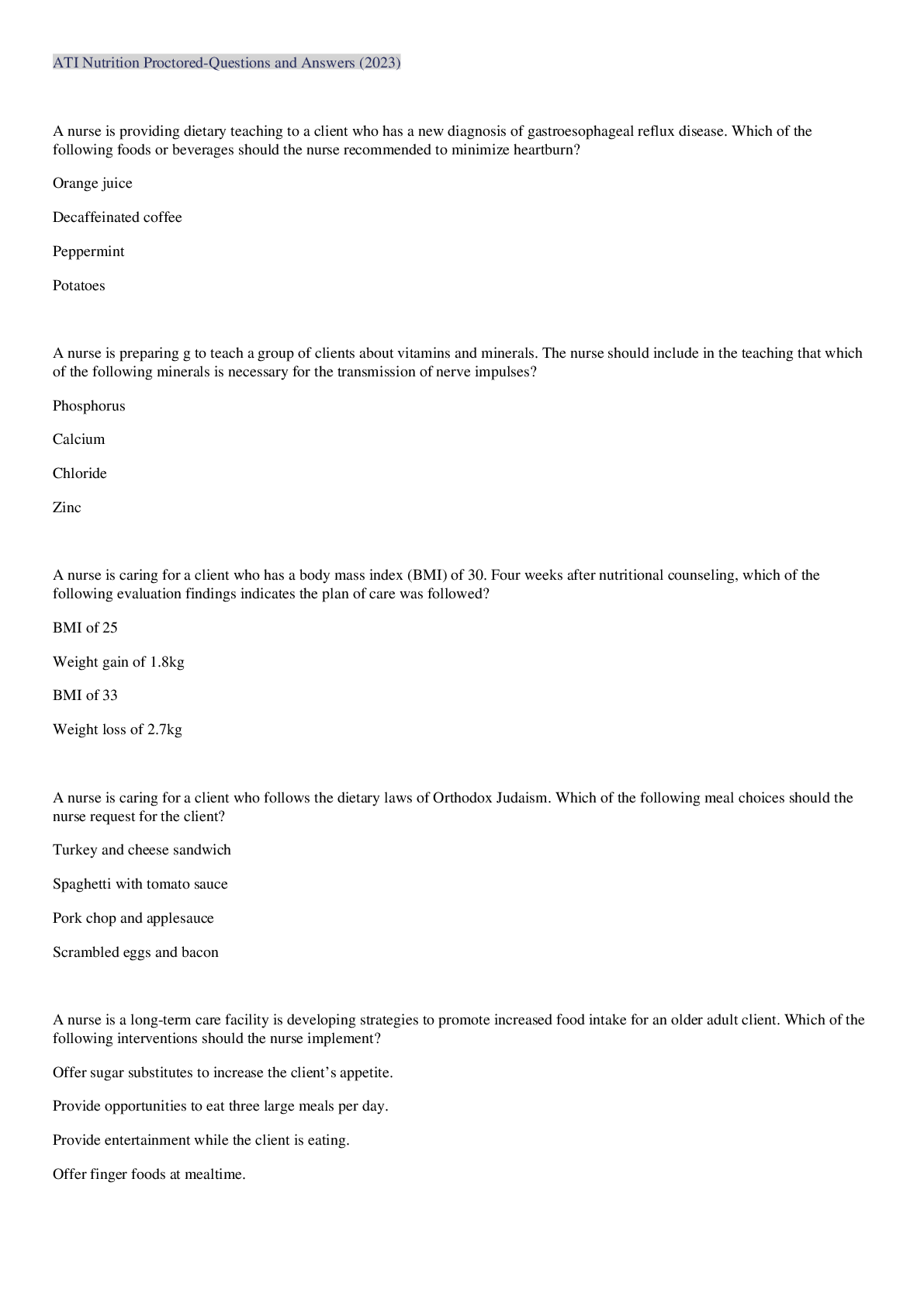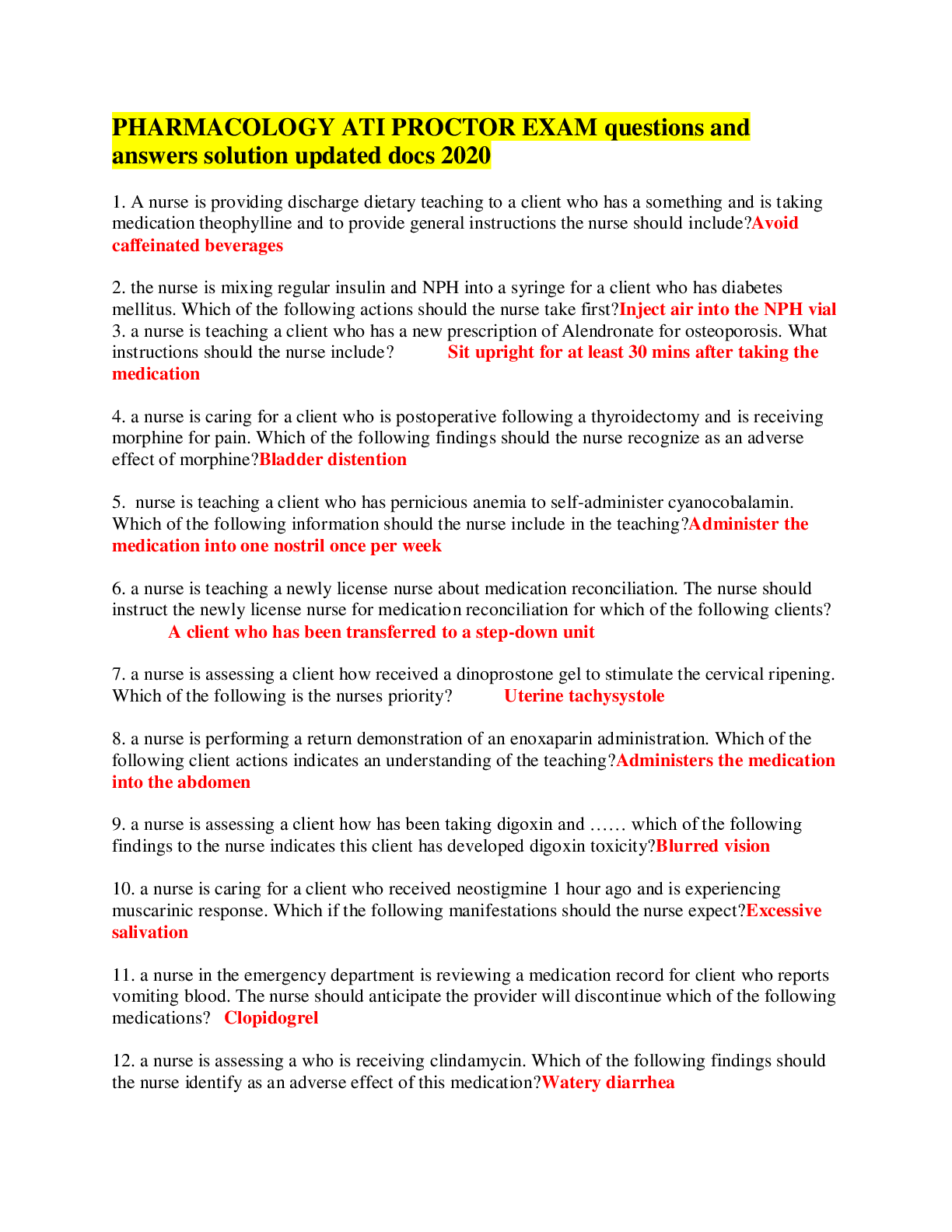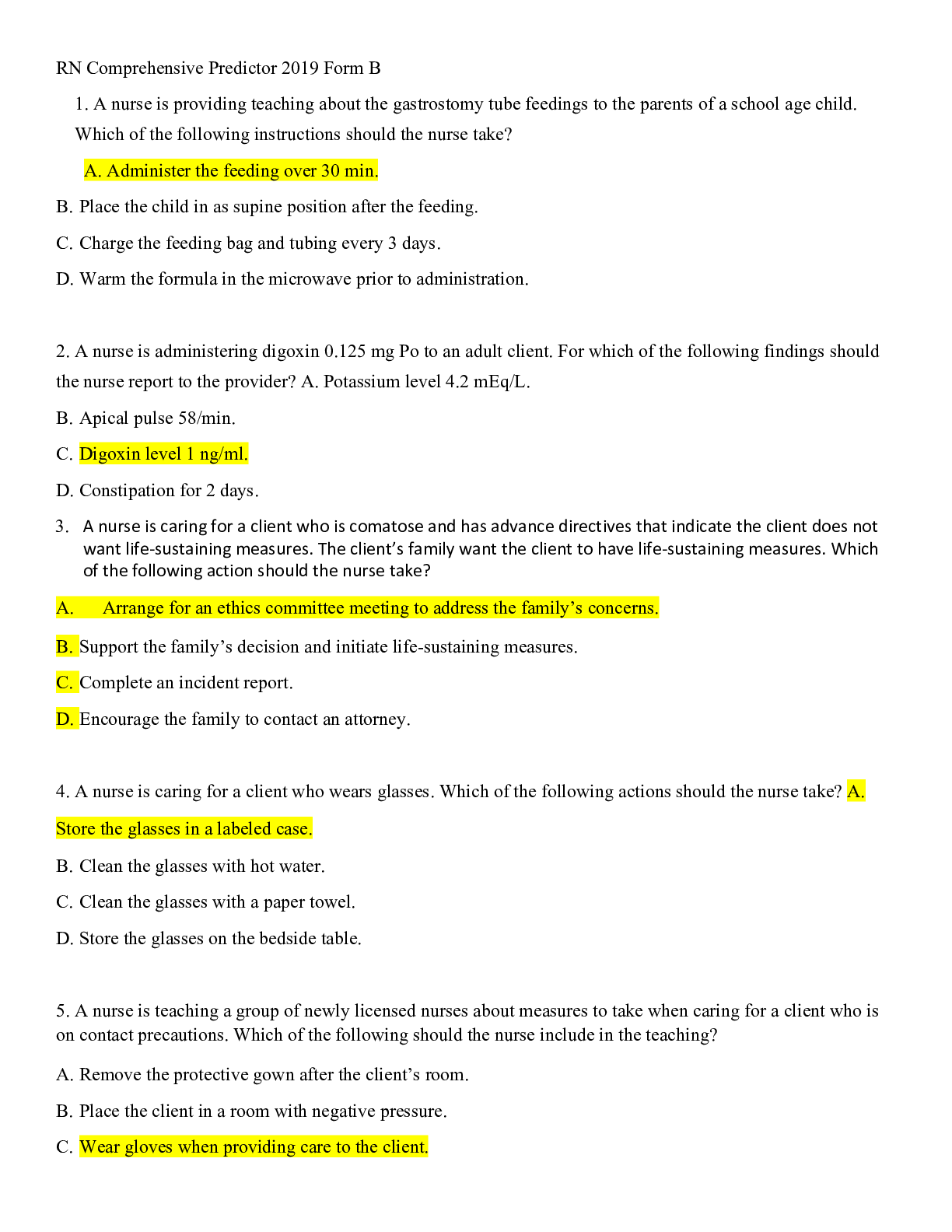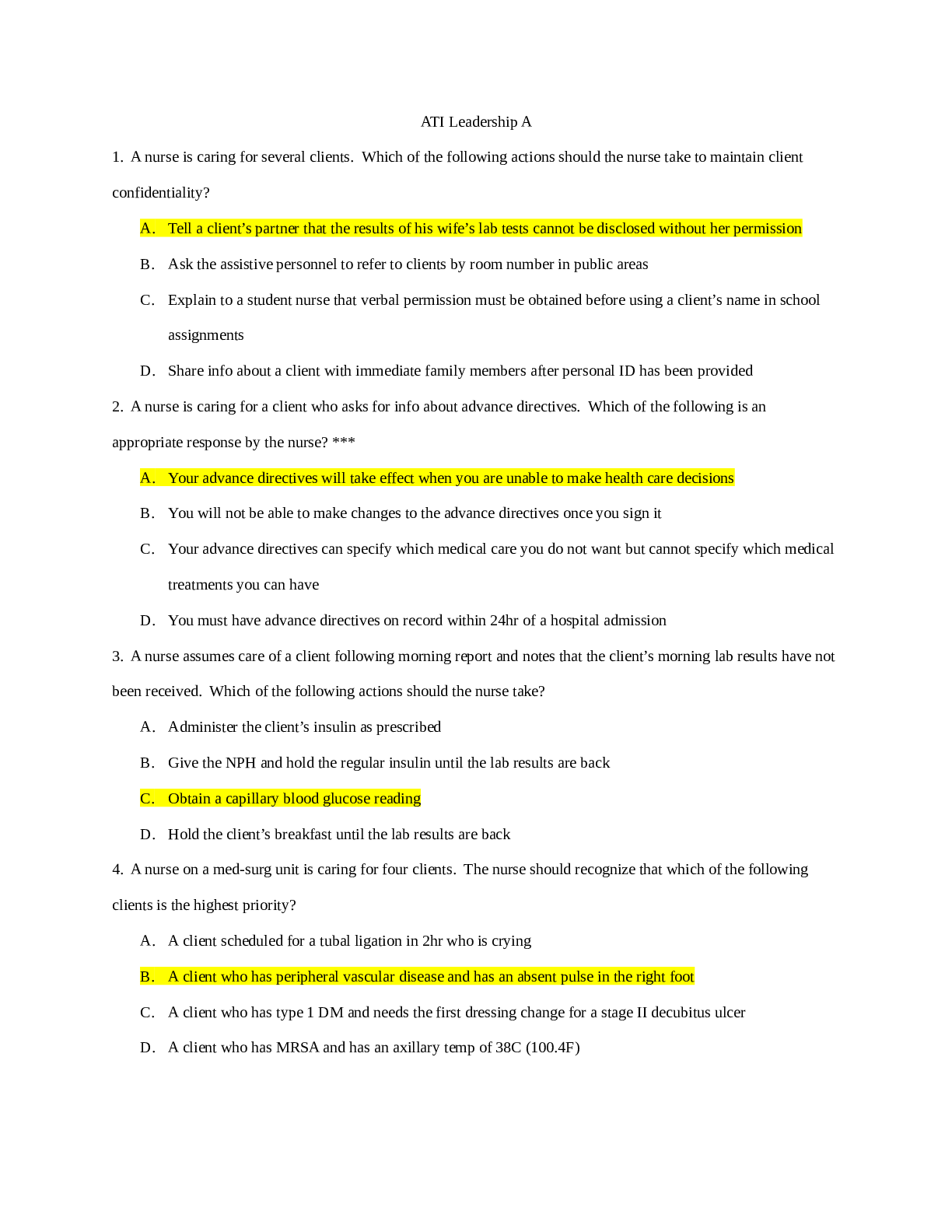NUR 6560 ATI EXAM - QUESTIONS AND ANSWERS (LATEST VERSION)
Document Content and Description Below
NUR 6560 ATI EXAM - QUESTIONS AND ANSWERS (LATEST VERSION) 1. A nurse in an oncology clinic is assessing a client who has early stage Hodgkin's lymphoma. Which of t he following findings should the n... urse suspect? Oncology A. Bone and joint pain B. Enlarged lymph nodes C. Intermittent hematuria D. Productive cough 2. A nurse in the emergency department is caring for a client who has a snakebite on her arm. Which of the following interventions should the nurse implement? Dermatology A. Immobilize the limb at the level of the heart B. Apply a tourniquet to the affected limb C. Use a sterile scapula to incise the wound D. Apply ice to the skin over the snakebite wound 3. A nurse in a provider's office is teaching a client with a recent diagnosis of rheumatoid arthritis who has a new prescription for naproxen tablets. Which of the following statements by the client indicates the need for further teaching? A. "After taking this medication for 4 weeks, I’ll start to notice relief in my joints." B. "I can take an antacid with this medication for indigestion." C. "I can take this medication with aspirin." D. "The naproxen goes down easier when I crush it and put it in applesauce.” 4. A nurse is providing teaching to a client who has anemia and a new prescription for epoetin alfa. Which of the following pieces of information should the nurse include in the teaching? Hematology A. Hospitalization is required when administering each treatment. B. The maximum effect of the medication will occur in 6 months. C. Hypertension is a common adverse effect of this medication. D. Blood transfusions are needed with each treatment. 5. A nurse is teaching a client who has acute pyelonephritis. Which of the following instructions should the nurse include in the teaching? Renal & Urinary A. “You should complete the entire cycle of antibiotic therapy.” B. “You should maintain complete bed rest until manifestations decrease.” C. “You should drink 1,000 mL of fluid per day.” D. “You should avoid using NSAIDs for pain.” 6. A nurse is assessing a client who has a bleeding duodenal ulcer. Which of the following findings should the nurse expect? Gastrointestinal A. Emesis with a coffee-ground appearance B. Increased blood pressure C. Decreased heart rate D. Bright green stools 7. A nurse is providing teaching to the family of a client who has a new diagnosis of amyotrophic lateral sclerosis (ALS). Which of the following findings is an early manifestation of ALS? Neurosensory A. Sensory dysfunction B. Weakness of the distal extremities C. Decreased vision D. Altered temperature regulation 8. A nurse is providing teaching to a class about transient ischemic attacks (TIAs). Which of the following pieces of information should the nurse include in the teaching? Neurosensory A. A TIA can cause irreversible hemiparesis. B. A TIA can be the result of cerebral bleeding. C. A TIA can cause cerebral edema. D. A TIA can precede an ischemic stroke. 9. A nurse is caring for a client who has a major burn injury and is experiencing third spacing. Which of the following fluid or electrolyte imbalances should the nurse expect? Fluids, Electrolytes Imbalance A. Hypokalemia B. Hypernatremia C. Elevated Hct D. Decreased Hgb 10. A nurse is caring for a client who is receiving intermittent peritoneal dialysis. The nurse observes that the peritoneal fluid is not adequately draining. Which of the following actions should the nurse take? A. Turn the client from side to side B. Elevate the height of the dialysate bag C. Lower the head of the client’s bed D. Advance the catheter approximately 2.5 cm (1 in) further 11. A nurse is providing teaching about exercise to a client who has type 1 diabetes mellitus. Which of the following statements should the nurse include? Endocrine A. "You should exercise during a peak insulin time." B. "Wear a medical alert identification tag when you exercise." C. "Exercise can decrease the effects of insulin and cause your blood glucose levels to increase." D. "You will get the most benefit from exercise when your glucose levels are higher than normal. 12. A nurse is caring for a client who will receive brachytherapy to treat uterine cancer. The nurse should ensure the client understands that she will receive which of the following interventions? Oncology A. Chemotherapy via a central venous access device B. Radiation to the tumor from an external source C. Precise delivery of high-dose radiation after tumor imaging D. Radioactive infusions or insertions into or near the tumor 13. A client is admitted to the emergency department following a motorcycle crash. The nurse notes a crackling sensation upon palpation of the right side of the client's chest. After notifying the provider, the nurse should document this finding as which of the following? Respiratory A. Friction rub B. Crackles C. Crepitus D. Tactile fremitus 14. A nurse in the emergency department is assessing a client for closed pneumothorax and significant bruising of the left chest following a motor-vehicle crash. The client reports severe left chest pain on inspiration. The nurse should assess the client for which of the following manifestations of pneumothorax? Respiratory A. Absence of breath sounds B. Expiratory wheezing C. Inspiratory stridor D. Rhonchi 15. A nurse is recommending dietary modifications for a client who has GERD. The nurse should suggest eliminating which of the following foods from the client's diet? Gastrointestinal A. Oranges and tomatoes B. Carrots and bananas C. Potatoes and squash D. Whole wheat and beans 16. A nurse is caring for a client who is recovering at home after inpatient treatment for burn injuries. To increase the protein density of the client's meals, which of the following recommendations should the nurse make to the client's caregiver? Nutrition A. Use sour cream instead of plain yogurt B. Add honey to cooked cereals C. Use salad dressing in place of mayonnaise D. Add chopped hard-boiled eggs to soups and casseroles 17. A nurse is caring for a client who has type 2 diabetes mellitus and is displaying manifestations of hyperglycemia. Which of the following findings should indicate to the nurse that the client has hyperglycemia? Endocrine A. Hunger B. Increased urination C. Cold, clammy skin D. Tremors 18. A nurse is caring for a client who has a lesion on the back of his right hand. The client asks the nurse which type of skin cancer is the most serious. Which of the following responses by the nurse is appropriate? Oncology A. Basal cell carcinoma B. Melanoma C. Actinic keratosis D. Squamous cell carcinoma 19. A nurse is caring for an older adult client who had an acute myocardial infarction (MI). When assessing this client, the nurse should identify that older adults are prone to complications of MI from poor tissue perfusion because of which of the following age- related factors? Cardiovascular A. Peripheral vascular resistance increases. B. The sensitivity of blood pressure-adjusting baroreceptors increases. C. Blood is hypercoagulable and clots more quickly. D. Cardiac medications are less effective. 20. A nurse is performing a preoperative assessment of a client about to undergo a cholecystectomy. The nurse should identify a risk for a latex allergy when the client reports an allergy to which of the following foods? A. Cabbage B. Oatmeal C. Milk D. Bananas 21. A nurse is caring for a client who had a below-the-knee amputation for gangrene of the right foot. The client reports sensations of burning and crushing pain in the toes of the absent right foot. Which of the following statements should the nurse make? A. "This type of pain usually decreases over time as the limb becomes less sensitive." B. "Try to look at the surgical wound as a reminder the limb is gone." C. "Use a cold compress intermittently to decrease these pain sensations." D. "Grief over the lost limb can sometimes cause denial that the limb is really gone." 22. A nurse is providing discharge teaching to the partner of a client who has a new diagnosis of hepatitis A. Which of the following instructions should the nurse include in the teaching? Immune & Infection A. "During this illness, she may take acetaminophen for fevers or discomfort." B. "Encourage her to eat foods that are high in carbohydrates." C. "The provider will prescribe a medication to help her liver heal faster." D. "Have her perform moderate exercise to restore her strength more quickly 23. A nurse is caring for a client immediately following extubation. Which of the following manifestations indicates that the nurse should call the rapid response team? A. Stridor B. Coughing C. Hoarseness D. Extensive oral secretions 24. A nurse is teaching a client with arthritis who is experiencing joint pain that impairs mobility. Which of the following instructions should the nurse include? Musculoskeletal A. "Engage your joints in resistance exercises." B. "Avoid using assistive devices when walking." C. "Perform passive exercises." D. "Apply heat to your joints prior to exercising 25. A nurse is teaching a client who has diabetes mellitus about hypoglycemia. Which of the following manifestations should the nurse include? (Select all that apply.) A. Bradycardia B. Diaphoresis C. Deep, rapid respirations D. Palpitations E. Shakiness 26. A nurse is caring for a client who has a hearing impairment. Which of the following actions should the nurse take when communicating with the client? A. Face the client when speaking B. Speak in a loud voice C. Use a normal rate when speaking D. Avoid hand motions 27. A nurse is teaching a newly licensed nurse about collecting a 24-hr urine specimen for creatinine clearance. Which of the following instructions should the nurse include? Renal &Urinary A. Include the first voided specimen at the start of the collection period B. Discard the last voided specimen at the end of the collection period C. Place signs in the bathroom as a reminder about the test in progress D. Instruct the client to increase exercise during the 24-hr period 28. A nurse is providing teaching to the guardian of a child who has celiac disease. Which of the following foods should the nurse instruct the guardian to omit from the child's diet? Nutrition A. Cornflakes B. Reduced-fat milk C. Canned fruits D. Wheat bread 29. A nurse is assessing a client who has a positive tuberculin skin test. Which of the following findings indicates that the client has active tuberculosis? A. Rhinitis B. Air hunger C. Night sweats D. Weight gain 30. A nurse is teaching a client who had a vaginal hysterectomy with a bilateral oophorectomy. Which of the following pieces of information should the nurse include in the teaching? Vaginal dryness manifestation A. "Plan to use some type of birth control for up to 6 weeks after surgery." B. "Use a water-based lubricant when having sexual intercourse." C. "Expect to have an increase in bloody vaginal drainage during the first 10 days after surgery." D. "Plan to start some type of aerobic exercise such as swimming within a week after surgery 31. A nurse is providing discharge teaching to a client who has a new diagnosis of systemic lupus erythematosus (SLE). Which of the following statements by the client indicates an understanding of the teaching? Immune & Infection A. "I will need to take methotrexate even if I'm in remission." B. "I'm thankful that this type of lupus only affects the skin." C. "Each day I should apply a sunblock with a sun protection factor of 15." D. "A mild fever is common with SLE and usually does not require medical intervention." 32. A nurse on a medical-surgical unit is caring for a client who is postoperative following a hip replacement surgery. The client reports feeling apprehensive and restless. Which of the follow findings should the nurse recognize as an indication of a pulmonary embolism (PE)? Respiratory A. Sudden onset of dyspnea B. Tracheal deviation C. Bradycardia D. Difficulty swallowing 33. A nurse is planning care for a client who had a stroke. The client has hemiplegia and occasional urinary incontinence. Which of the following actions should the nurse include in the client’s plan of care? A. Offer the client a bedpan every 2 hr B. Limit the client’s daily fluid intake until he is no longer incontinent C. Request a prescription for an indwelling urinary catheter from the client’s provider D. Ambulate the client to the bathroom every 30 min 34. A nurse is preparing to transfuse a unit of packed red blood cells (RBCs) for a client who has anemia. Which of the following actions should the nurse take first? A. Hang an IV infusion of 0.9% sodium chloride with the blood B. Compare the client’s identification number with the number on the blood C. Witness the informed consent document D. Obtain pretransfusion vital signs 35. A nurse is preparing a client for an electroencephalogram (EEG). When the client asks the nurse what this test does, which of the following responses should the nurse provide? A. "An EEG measures the electric signals to your brain from hearing, sight, and touch." B. "An EEG measures the electrical activity in your muscles." C. "An EEG identifies the magnetic fields produced by electrical activity in your brain." D. "An EEG records the electrical activity of your brain cells." 36. A nurse is teaching a group of clients at a senior center about the risk factors for osteoporosis. Which of the following statements should the nurse include in the teaching? A. "Extended periods of immobility increase your risk of osteoporosis." B. "Prolonged periods of sun exposure increase your risk of osteoporosis." C. "Eating a diet high in protein can reduce your risk of osteoporosis." D. "Corticosteroid therapy will reduce your risk of osteoporosis." 37. A nurse is providing discharge teaching to a client who has a new permanent pacemaker. Which of the following statements by the client indicates an understanding of the teaching? A. "I should check my heart rate at the same time each day." B. "I don't have to take my antihypertensive medications now that I have a pacemaker." C. "I should keep a pressure dressing over the generator until the incision is healed." D. "I cannot stand in front of our new microwave oven when it is on." 38. A nurse is reviewing the laboratory results of a lumbar puncture (LP) for a client who has manifestations of bacterial meningitis. Which of the following findings should the nurse expect? A. Elevated glucose B. Elevated protein C. Presence of RBCs D. Presence of D-dimer 39. A nurse in an acute care clinic is talking with a client who reports that the osteoarthritis pain in her knees is increasing each day. The client wants to discuss nonpharmacological approaches to help relieve her pain. Which of the following interventions should the nurse suggest? A. Applying warm compresses to sore joints B. Decreasing the daily intake of dietary protein C. Keeping joints in extension during rest periods D. Limiting sleep to 6 to 7 hr per night 40. A nurse is caring for a client who is in hypovolemic shock. While waiting for a unit of blood, the nurse should administer which of the following IV solutions? Shock A. 0.45% sodium chloride B. Dextrose 5% in 0.9% sodium chloride C. Dextrose 10% in water D. 0.9% sodium chloride 41. A nurse in an acute care facility is preparing to admit a client who has myasthenia gravis. Which of the following supplies should the nurse place at the client’s bedside? A. Metered-dose inhaler B. Continuous passive motion machine C. Oral-nasal suction equipment D. External defibrillator pads 42. A nurse is planning care for a client who has AIDS and has developed stomatitis. Which of the following interventions should the nurse include in the plan of care? A. Rinse the mouth with chlorhexidine solution every 2 hr B. Limit fluid intake with meals C. Provide oral hygiene with a firm bristled toothbrush after each meal D. Avoid salty foods 43. A nurse is teaching a class of new parents about otitis media. Which of the following manifestations should the nurse include in the teaching? A. High-pitched sound heard in the ear B. Intermittent rapid eye movement C. Itching of the external canal D. Feeling of fullness in the ear 44. A nurse is reviewing the dietary choices of a client who has chronic pancreatitis. Which of the following food items should the nurse suggest removing from the client's menu for the following day? A. White rice B. Broiled cod C. Ice cream D. Canned peaches 45. A nurse is caring for a client who had a left lower lobectomy to treat lung cancer. Which of the following factors will have a significant impact on the plan of care for this client? A. The client will need intensive smoking-cessation education. B. After surgery, the prognosis for clients with lung cancer is usually good. C. Lung cancer usually has metastasized before the client presents with symptoms. D. Oxygen therapy is ineffective following a lobectomy. 46. A nurse is reviewing the medical history of a client who is scheduled for a magnetic resonance imaging (MRI) examination of the cervical vertebra. Which of the following pieces of information in the client’s history is a contraindication to this procedure? A. The client has a new tattoo. B. The client is unable to sit upright. C. The client has a history of peripheral vascular disease. D. The client has a pacemaker. 47. A nurse is caring for a client who has ulcerative colitis. The provider prescribes bed rest with bathroom privileges. When the client asks the nurse why he has to say in bed, which of the following responses should the nurse provide? A. "You need to conserve energy at this time." B. "Lying quietly in bed helps slow down the activity in your intestines." C. "Staying in bed promotes the rest and comfort you need." D. "Staying in bed will help prevent injury and minimize your fall risk." 48. A nurse is reviewing the laboratory report of a client who has chronic kidney disease (CKD). The nurse finds the following laboratory test results: potassium 6.8 mEq/L, calcium 7.4 mg/dL, hemoglobin 10.2 g/dL, and phosphate 4.8 mg/dL. Which finding is the priority for the nurse to report to the provider? Fluids & Electrolytes Imbalance A. Hypocalcemia B. Hyperkalemia C. Anemia D. Hypoalbuminemia 49. A nurse is completing a history and physical assessment for a client who has chronic pancreatitis. Which of the following findings should the nurse identify as a likely cause of the client’s condition? A. High-calorie diet B. Prior gastrointestinal illnesses C. Tobacco use D. Alcohol use 50. A nurse is caring for a client who has systemic lupus erythematosus (SLE) and is concerned about skin lesions on her face and neck. The client asks the nurse, "What should I do about these spots?" Which of the following responses should the nurse give? A. "Keep the lesions covered with a light sterile dressing when going outdoors." B. "Rub lesions with a washcloth to dry after washing." C. "Apply moisturizer after bathing the lesions with warm water." D. "Apply antibiotic cream twice per day until scabs form on the lesions." 100. A nurse is assessing a client who has Addison’s disease. Which of the following skin manifestations should the nurse expect to find? A. Purple striae on the chest and abdomen B. Butterfly rash across the bridge of the nose C. Bronze pigmentation of the skin D. Jaundice of the face and sclera [Show More]
Last updated: 1 year ago
Preview 1 out of 76 pages
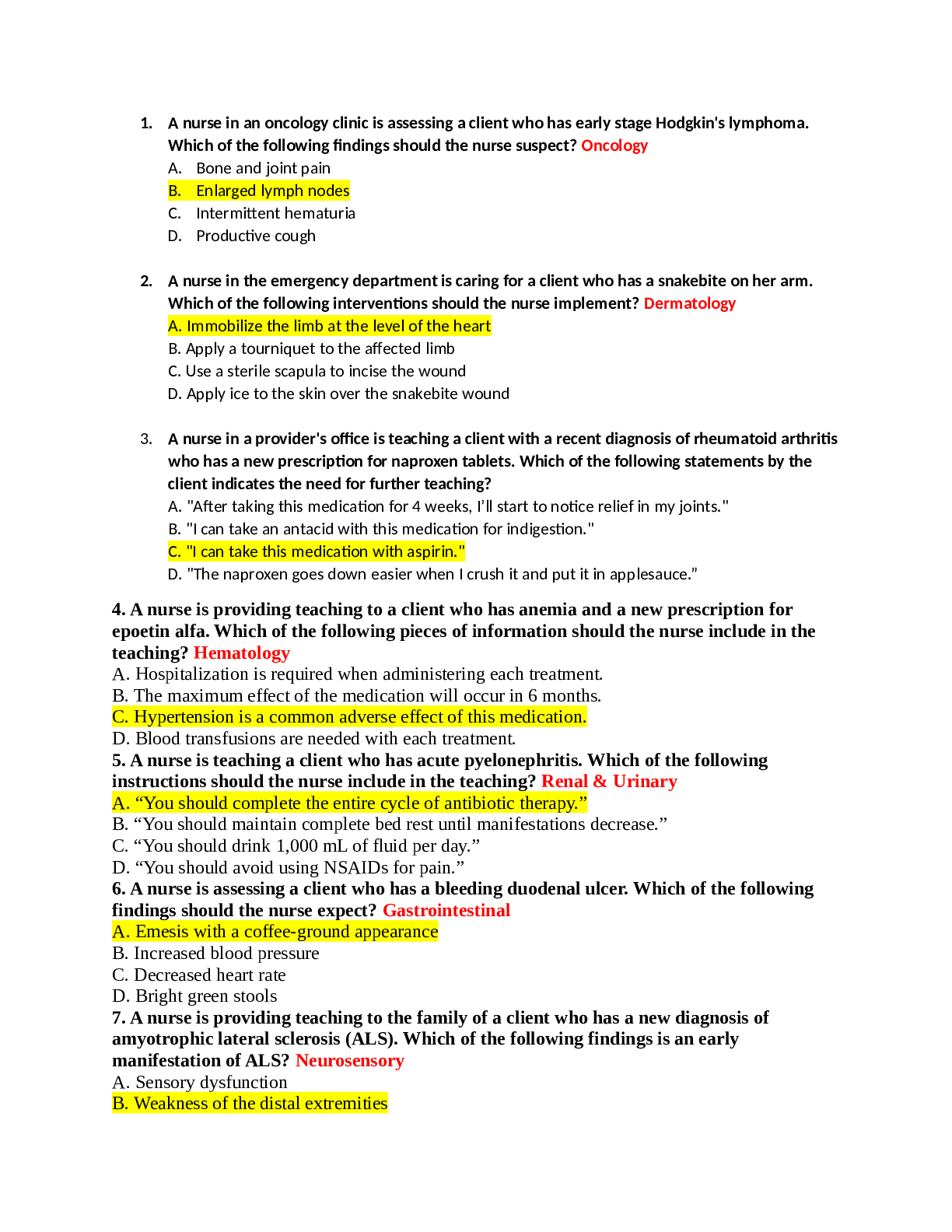
Reviews( 0 )
Document information
Connected school, study & course
About the document
Uploaded On
Jan 11, 2022
Number of pages
76
Written in
Additional information
This document has been written for:
Uploaded
Jan 11, 2022
Downloads
0
Views
41


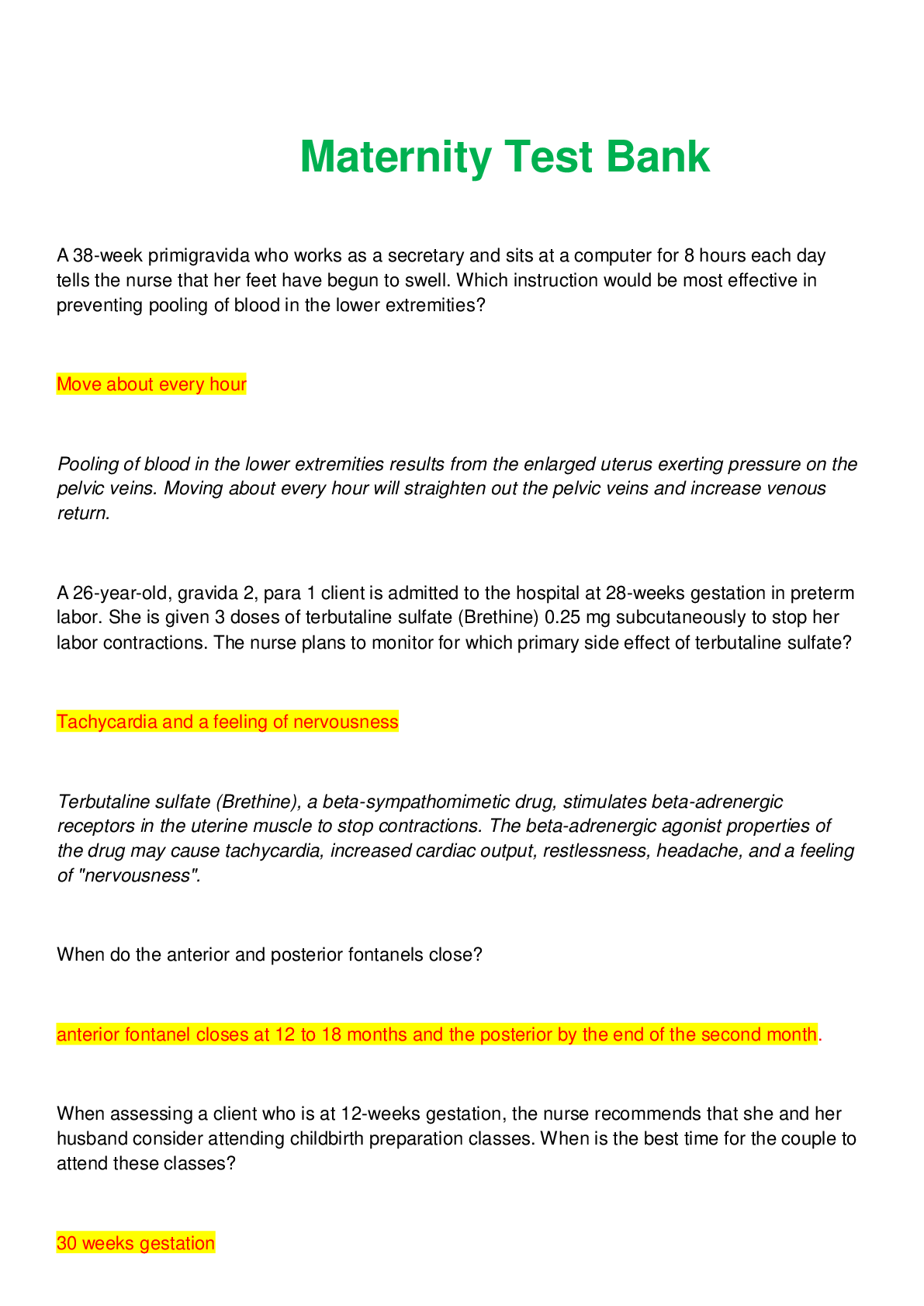


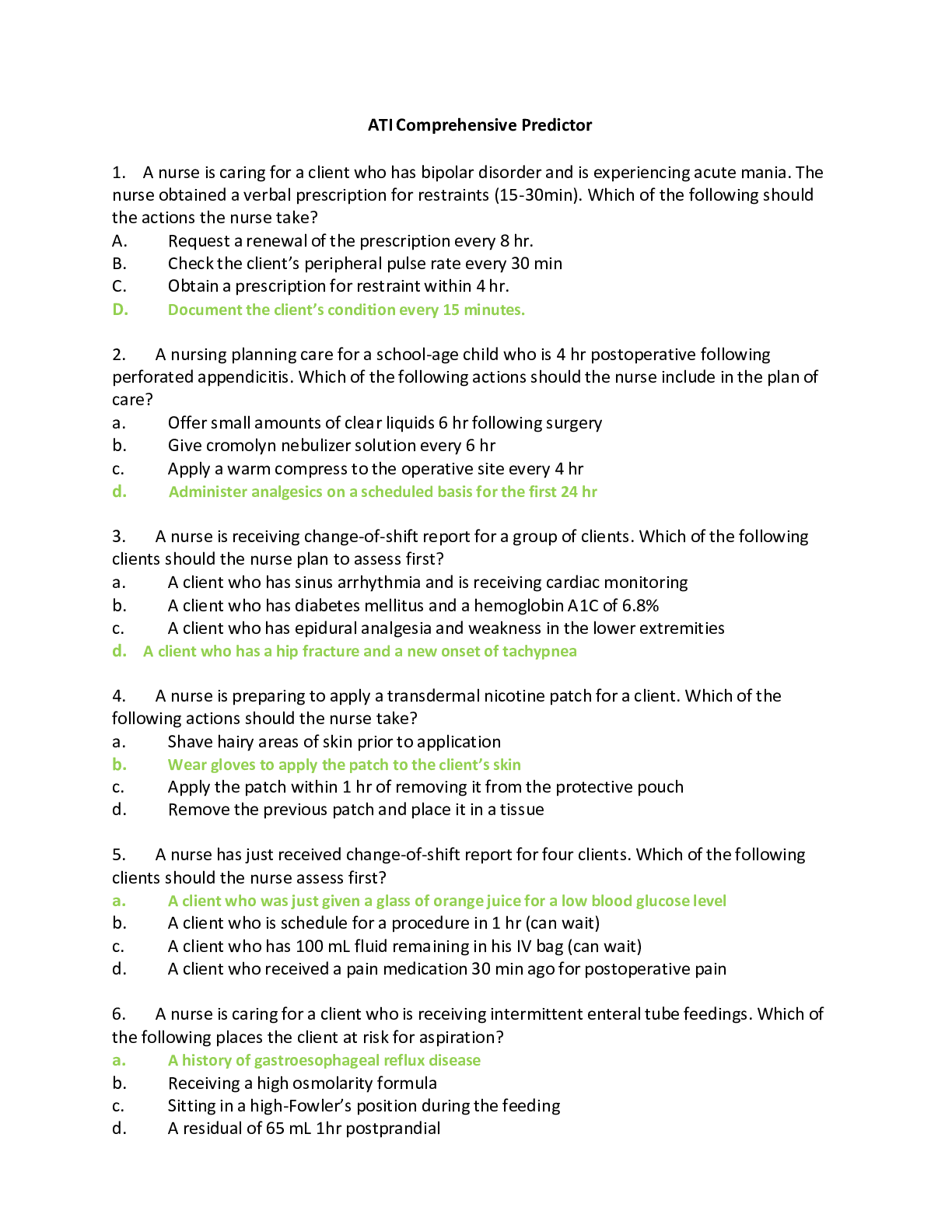


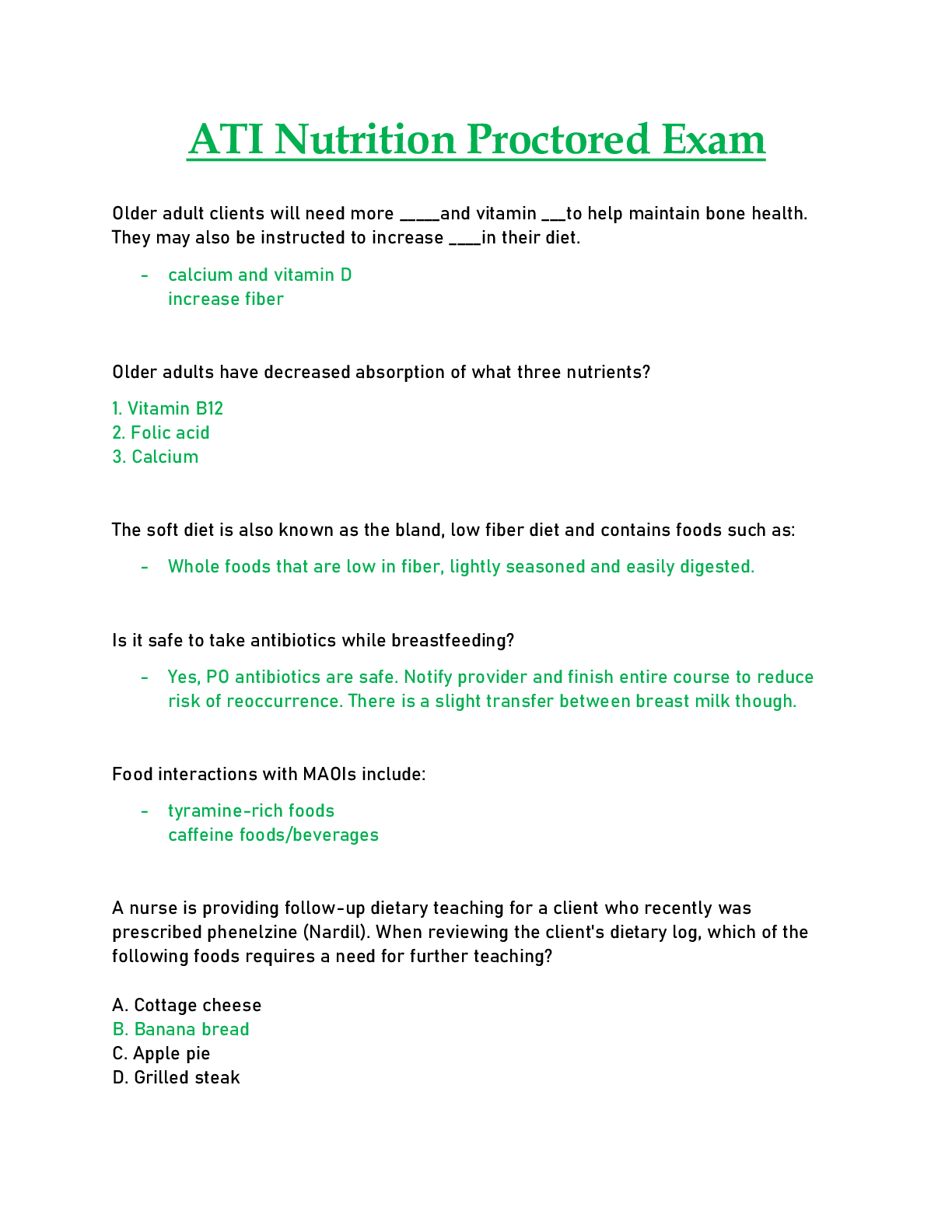

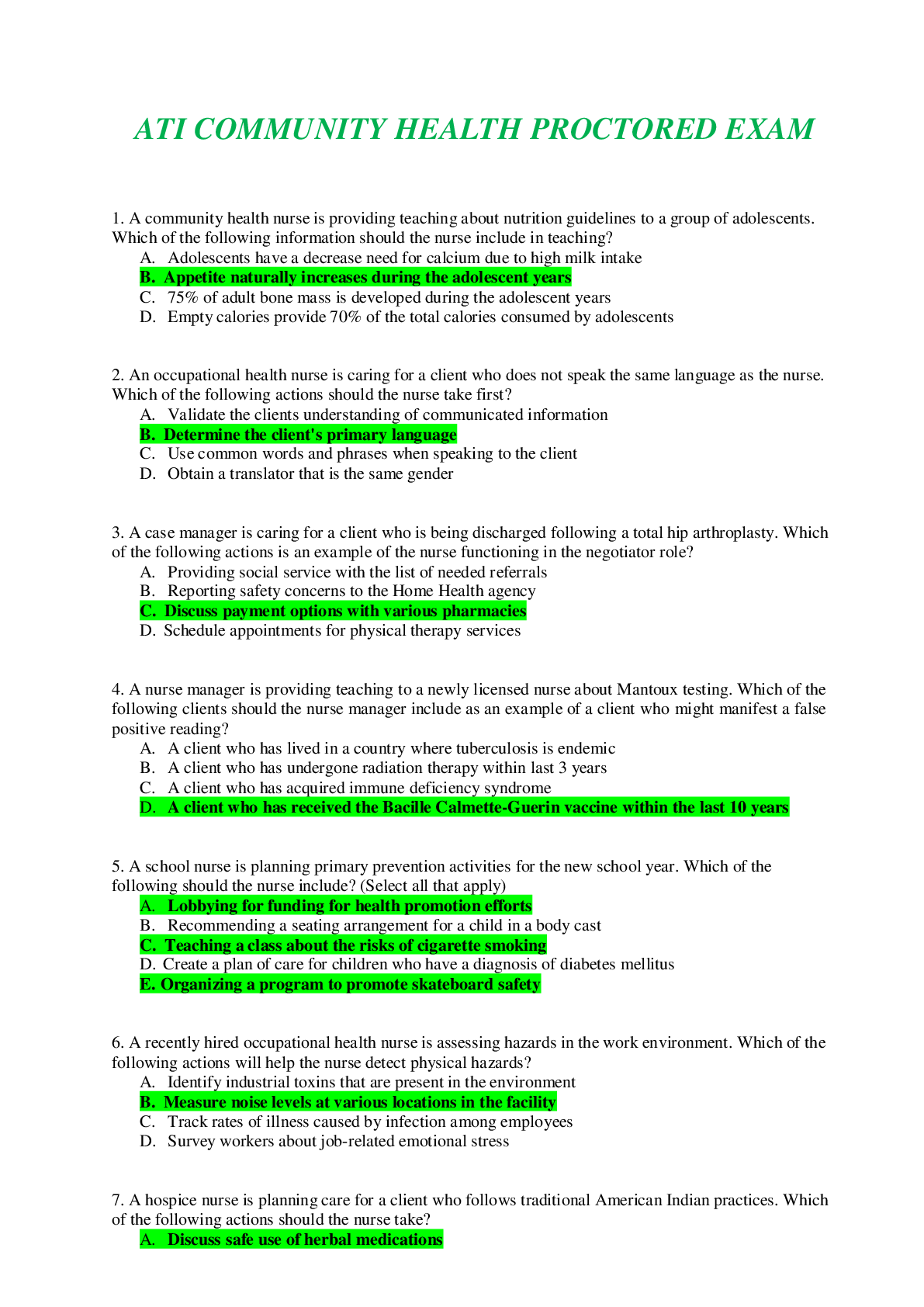
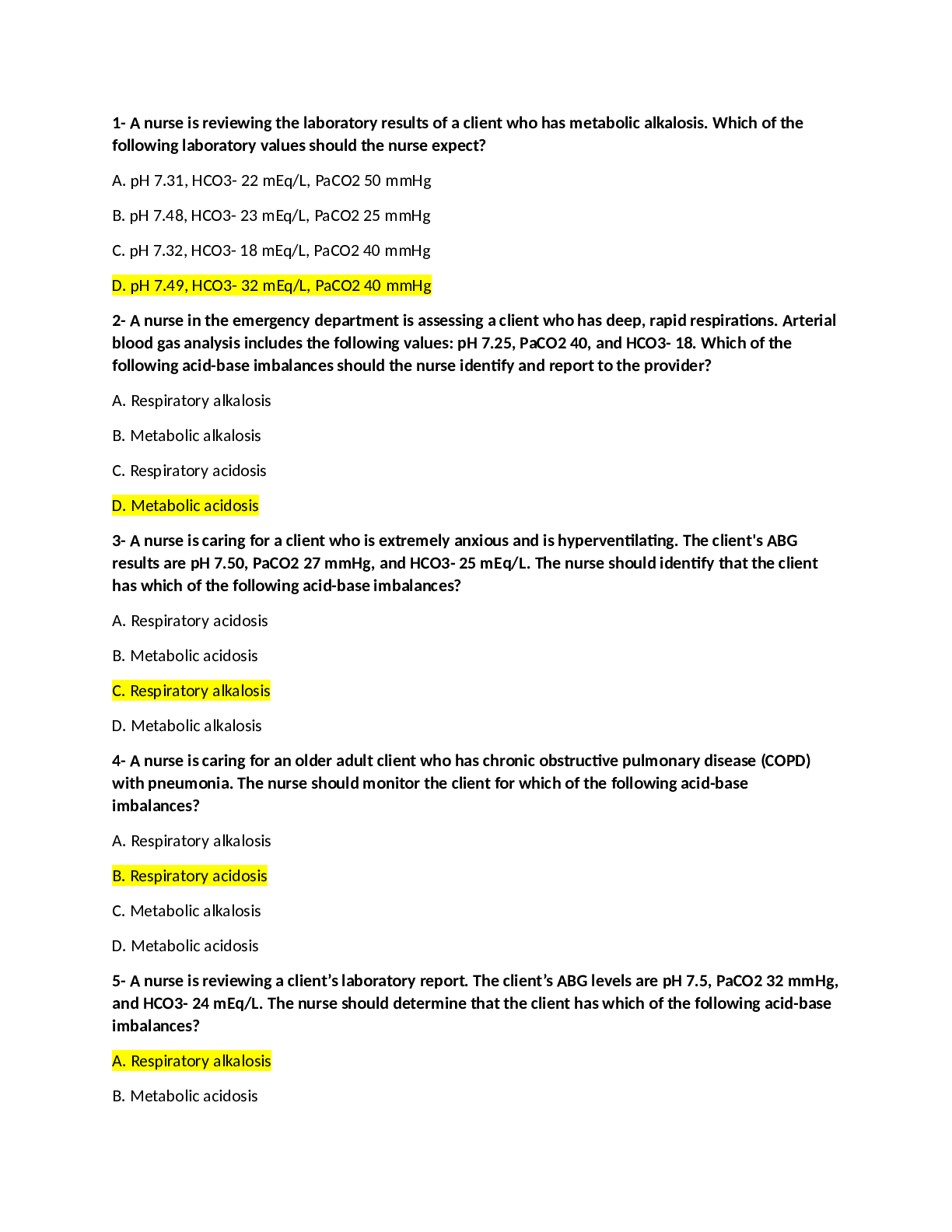
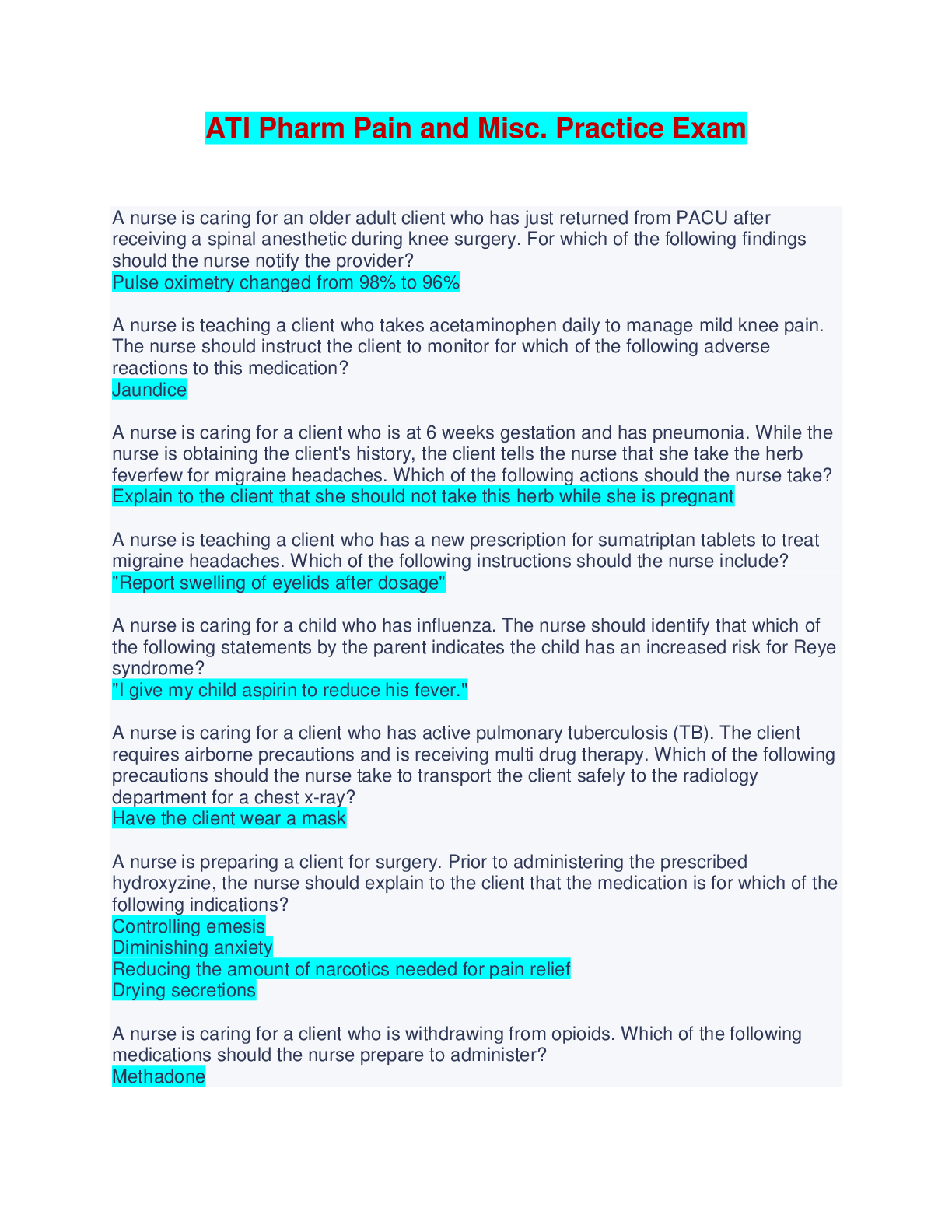
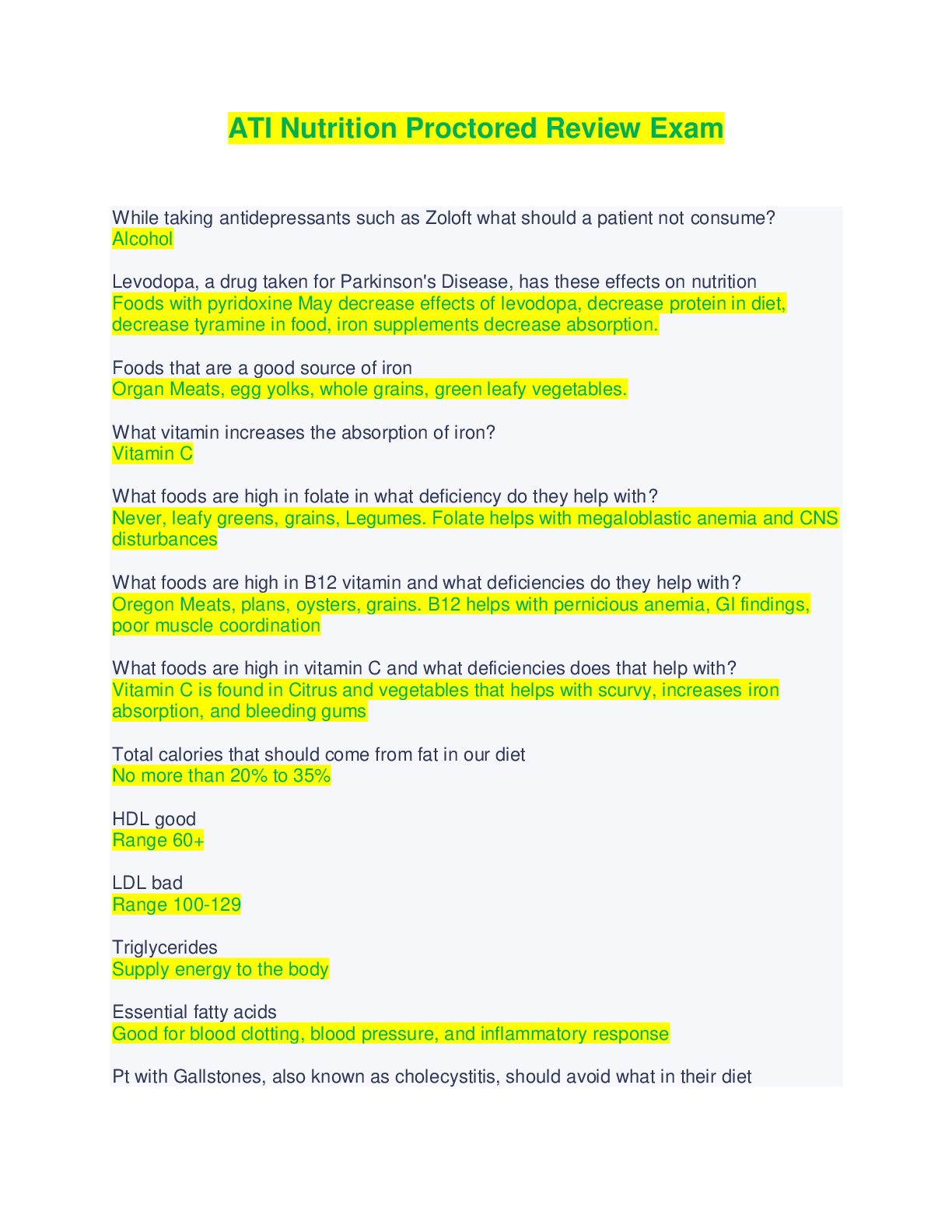
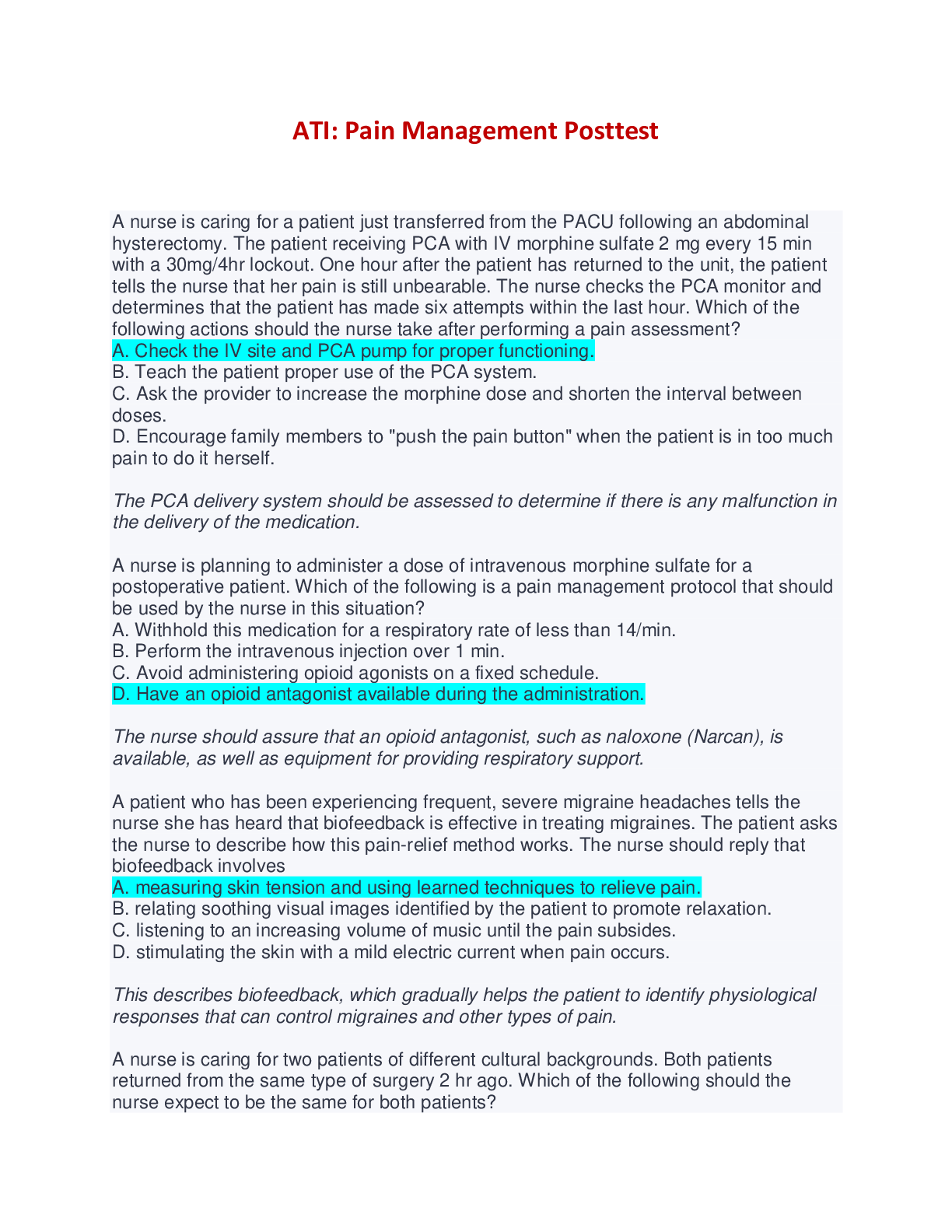
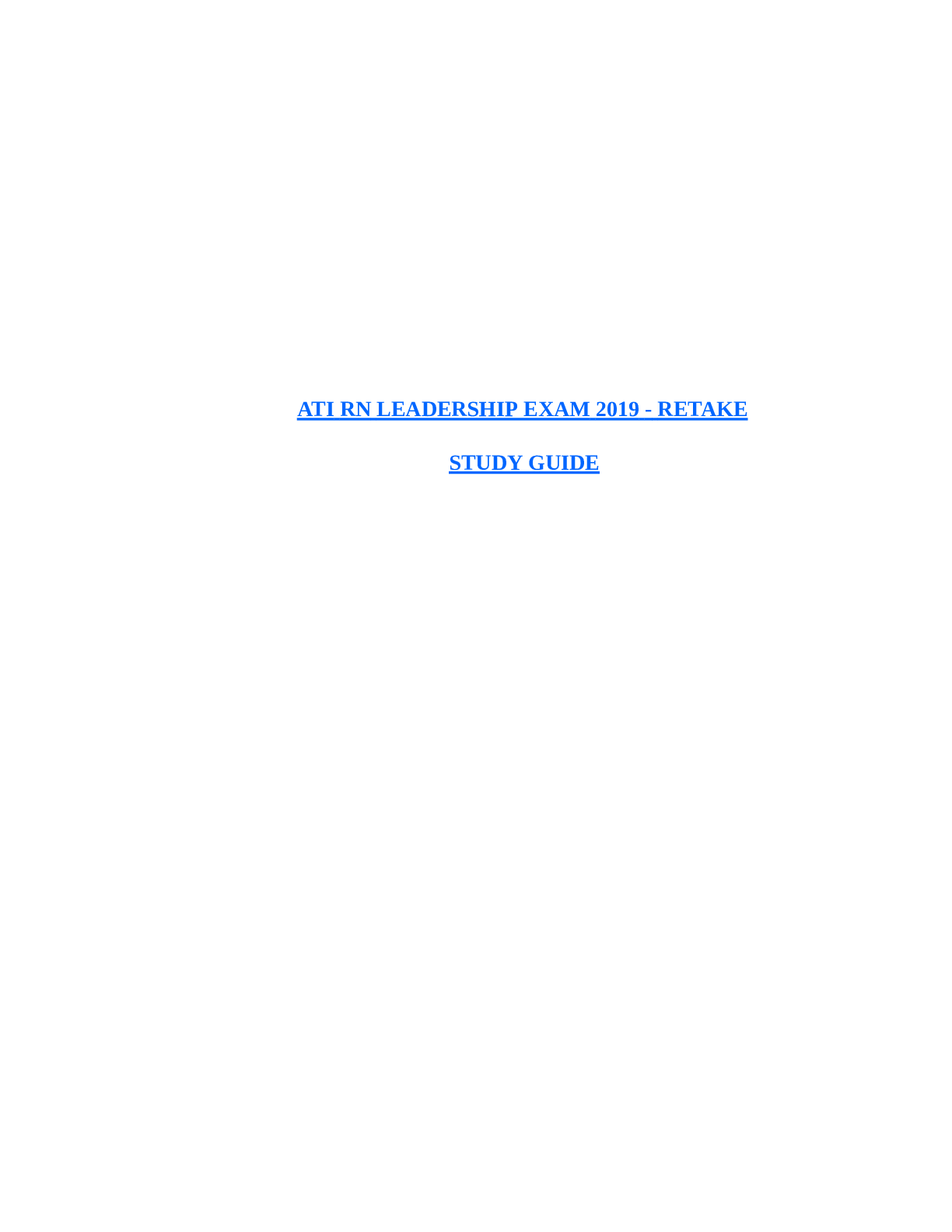

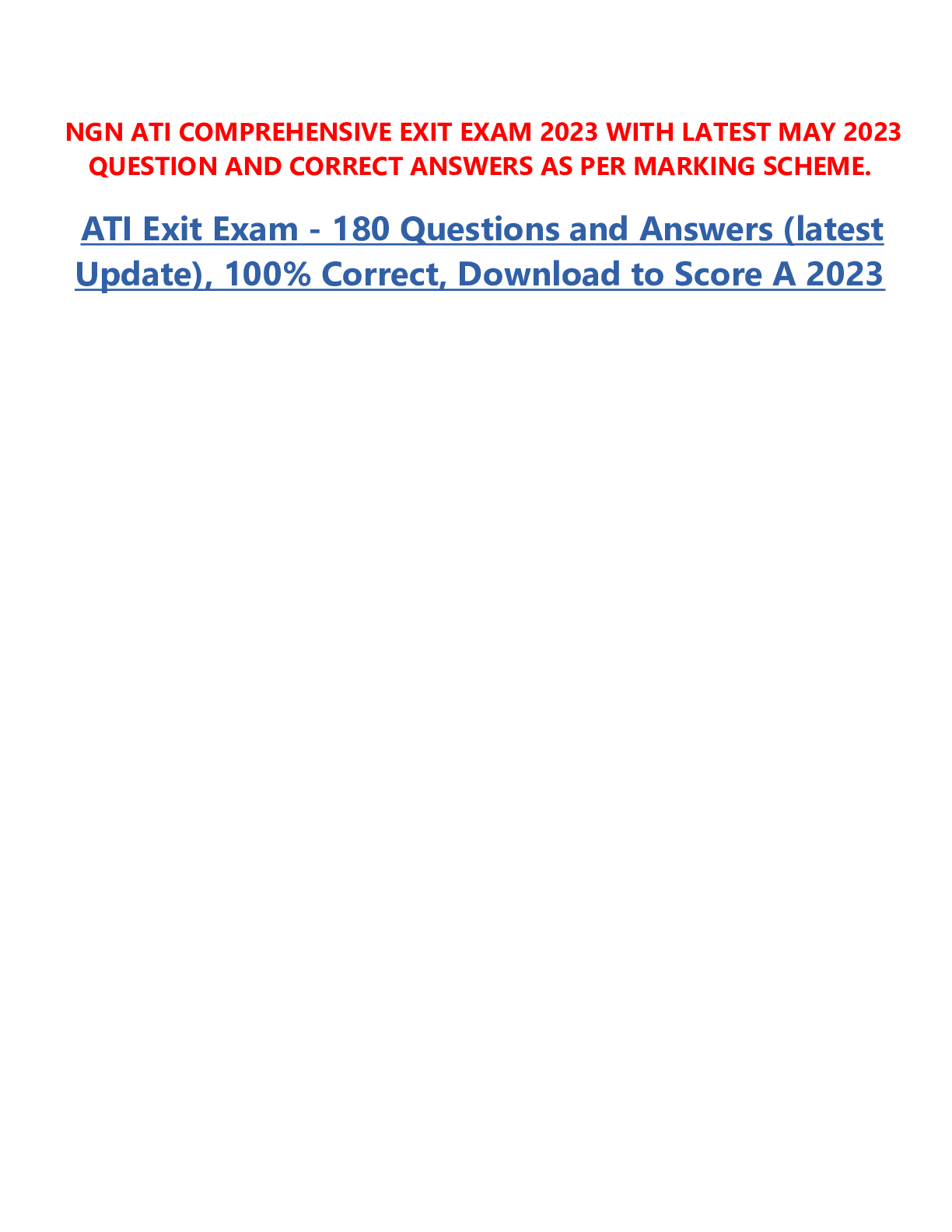
_Already Graded A.png)
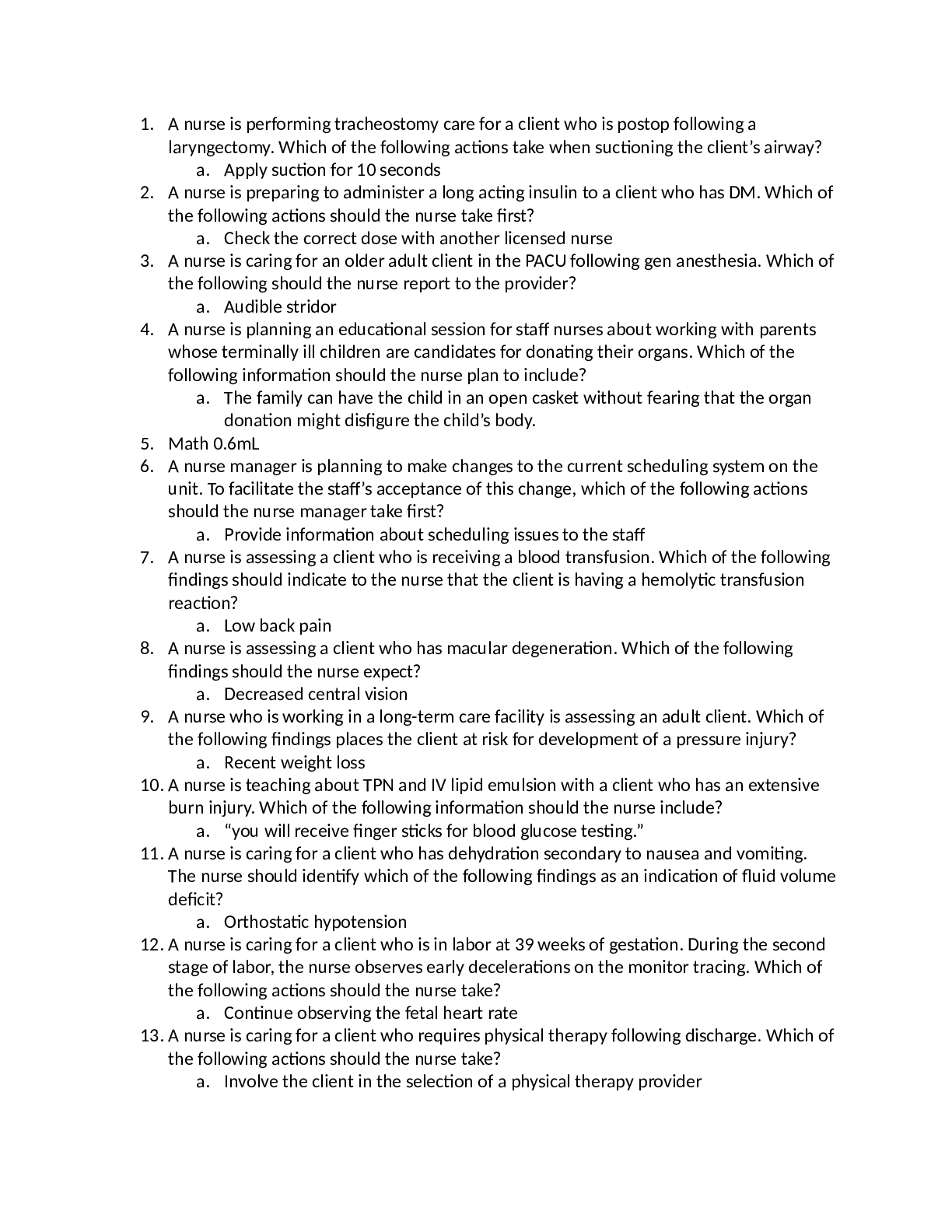
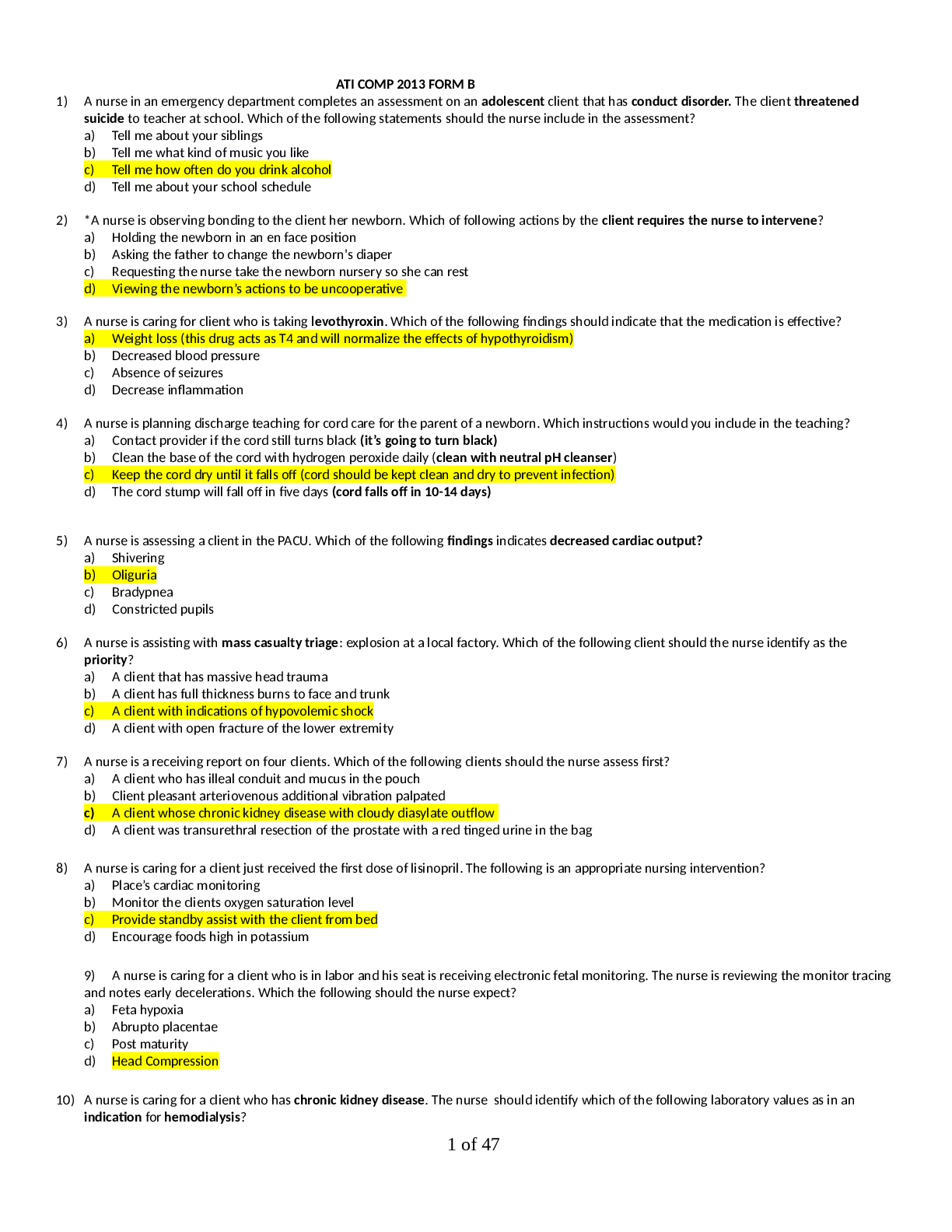
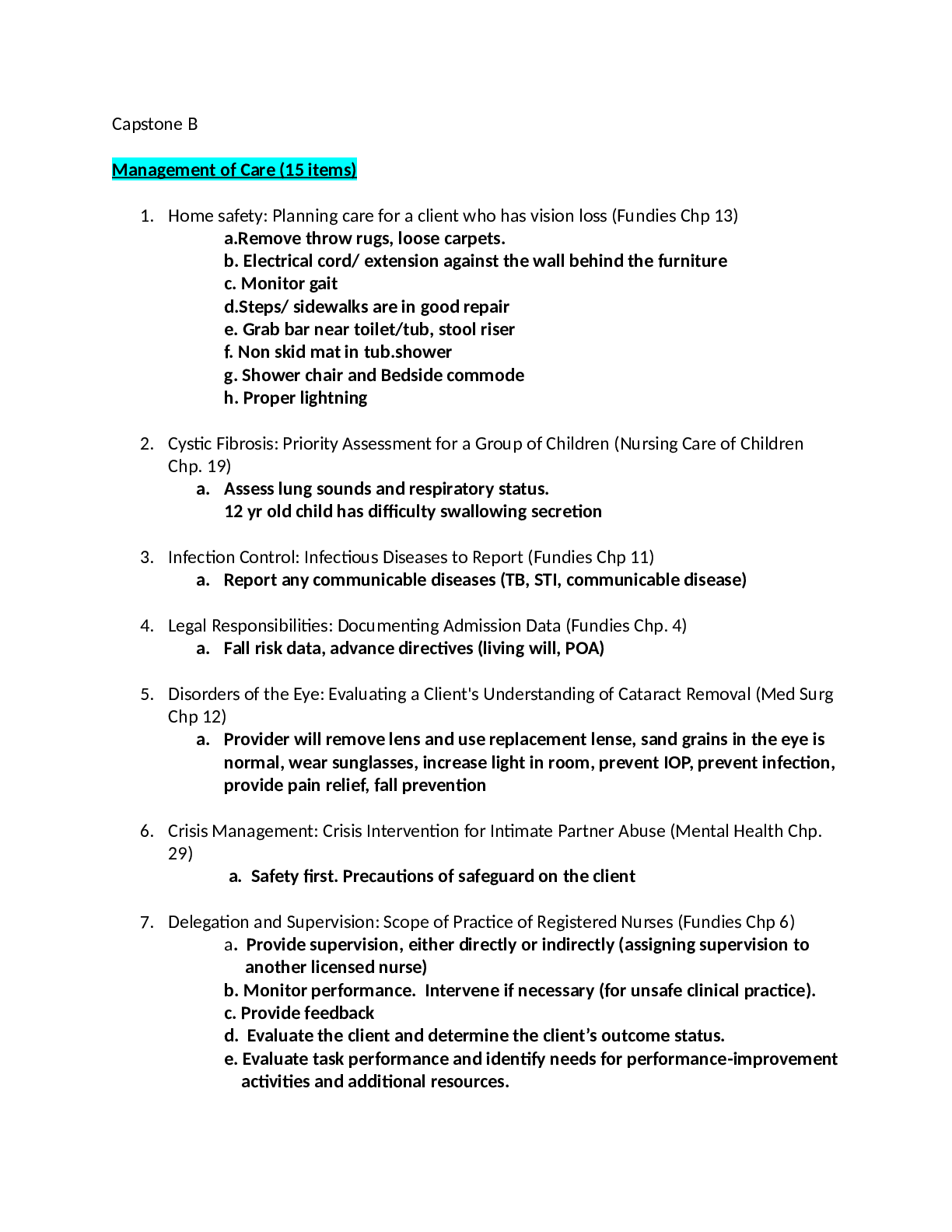
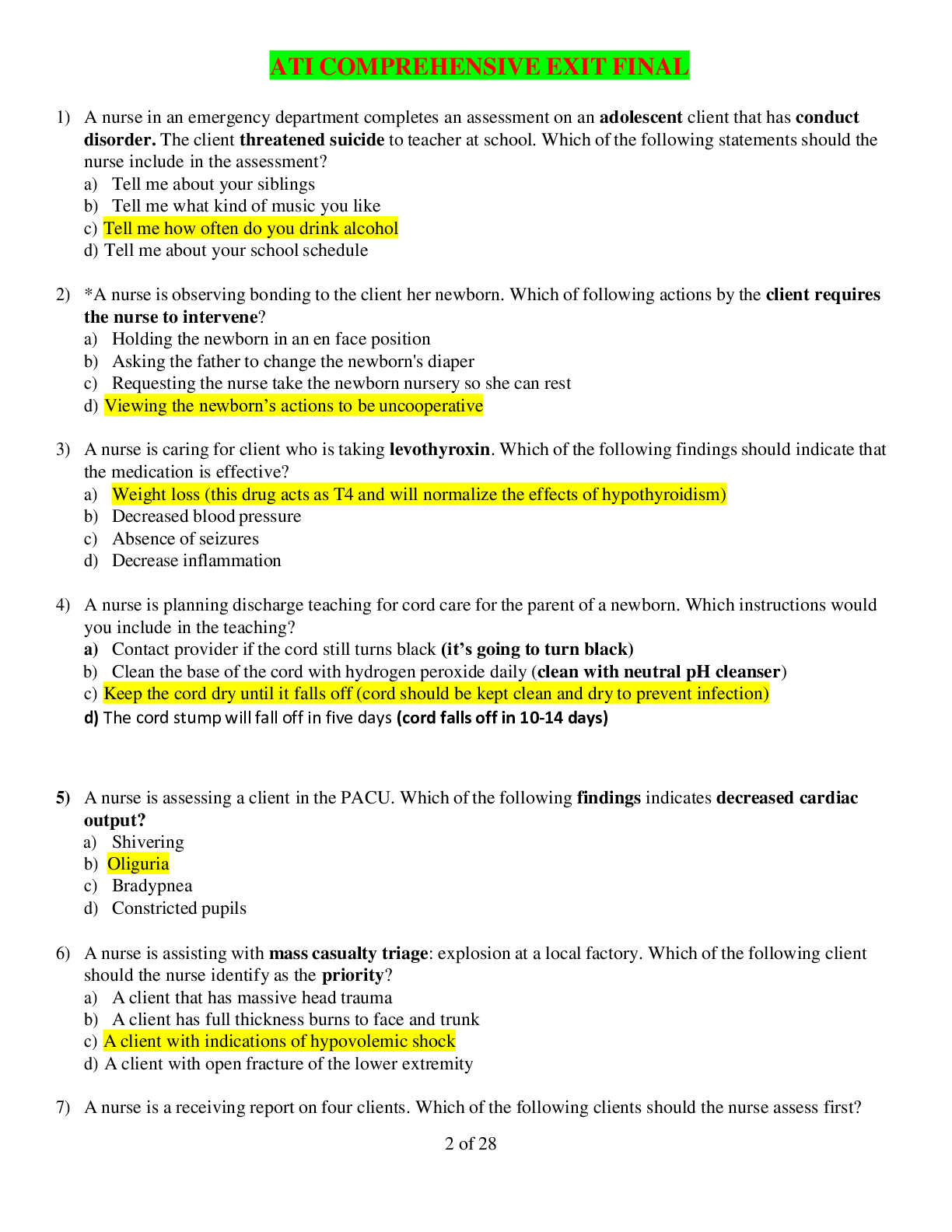
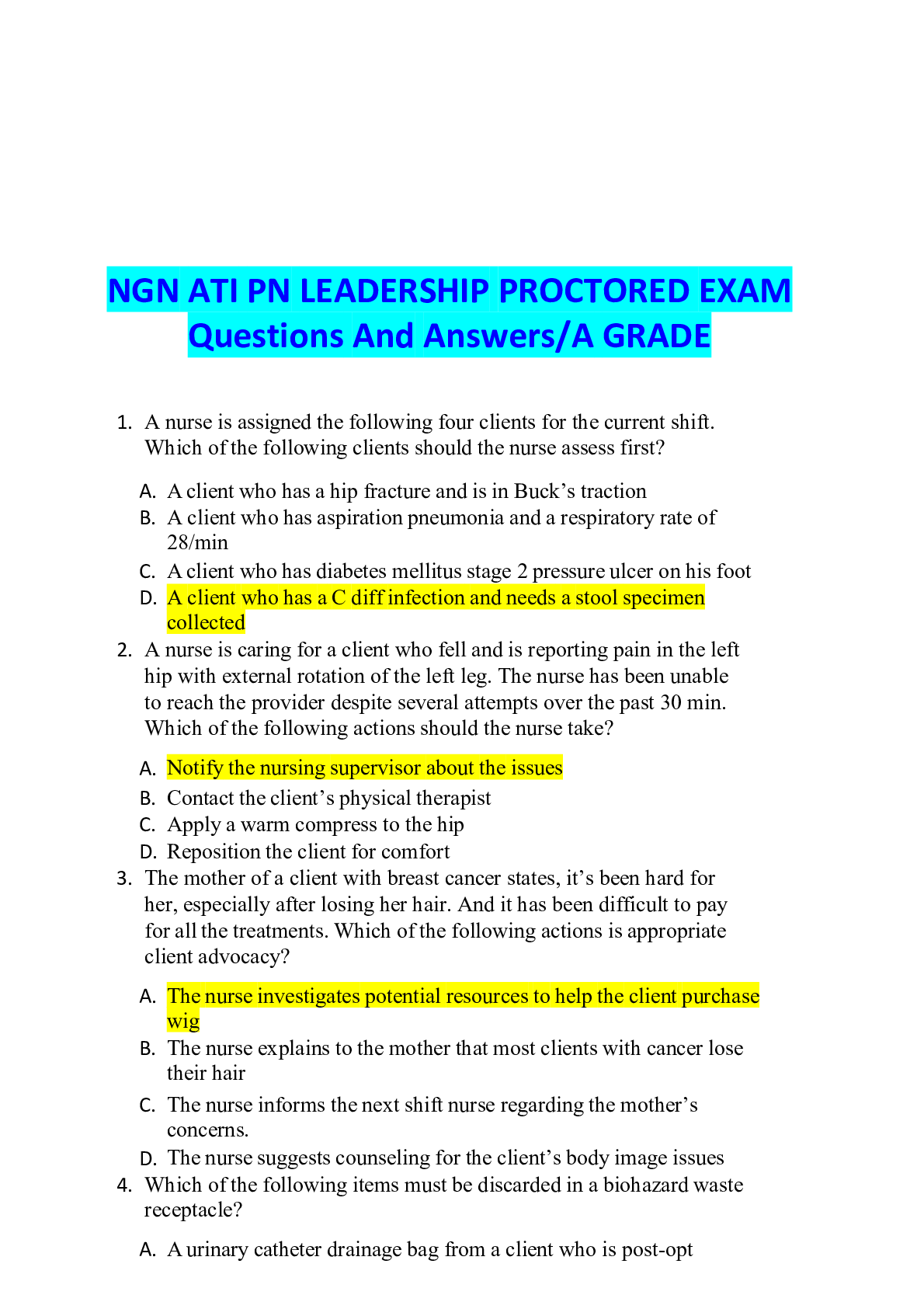
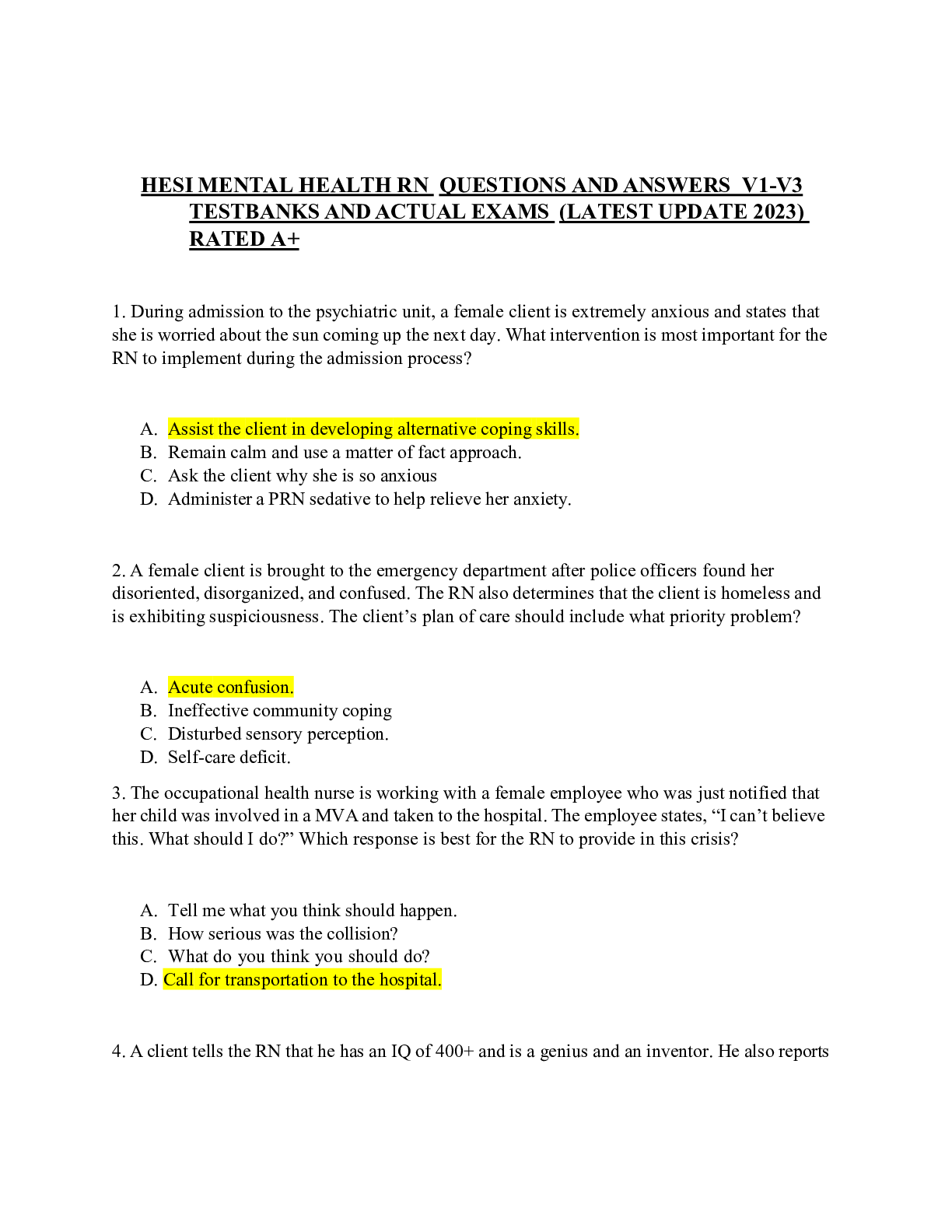

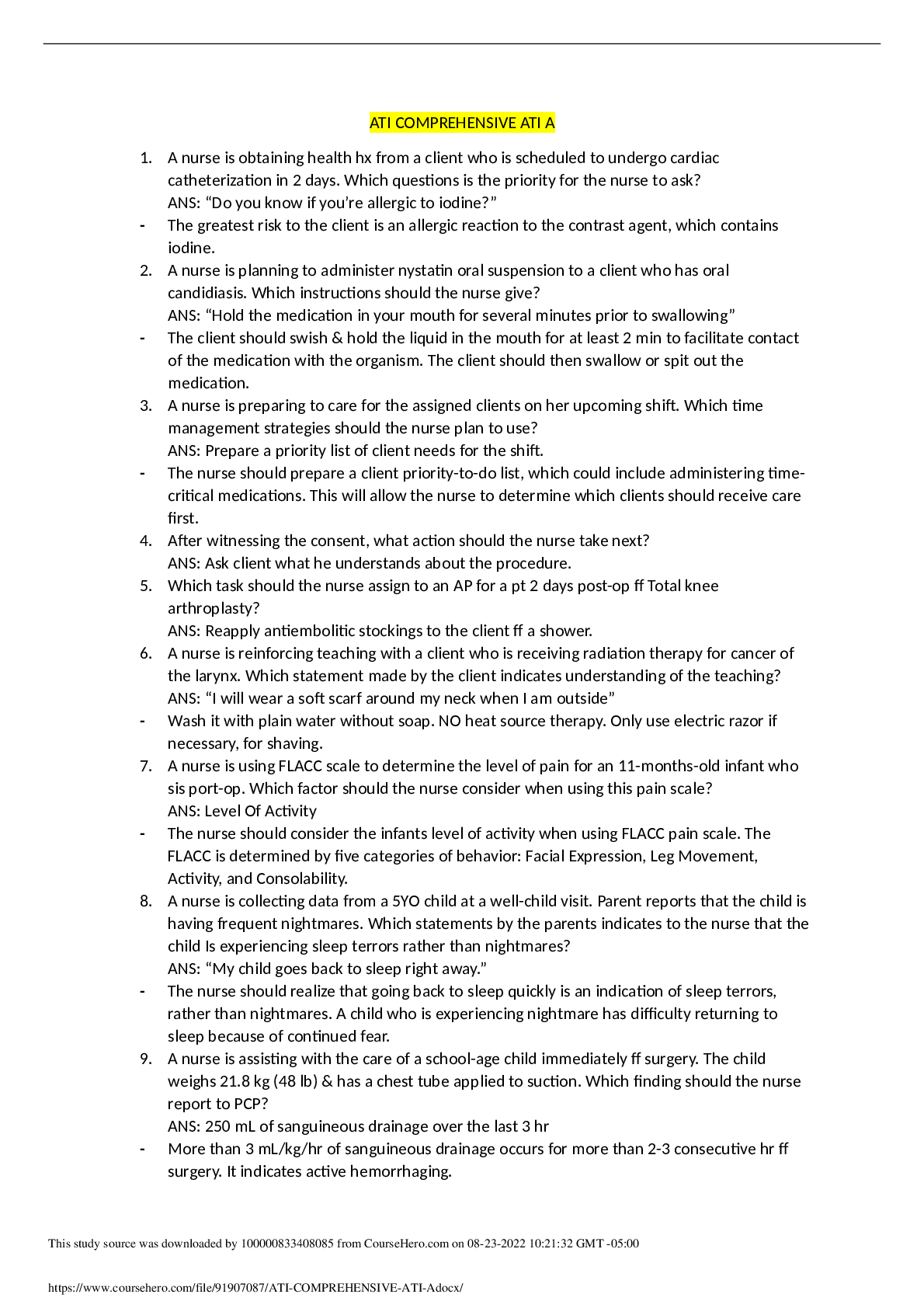

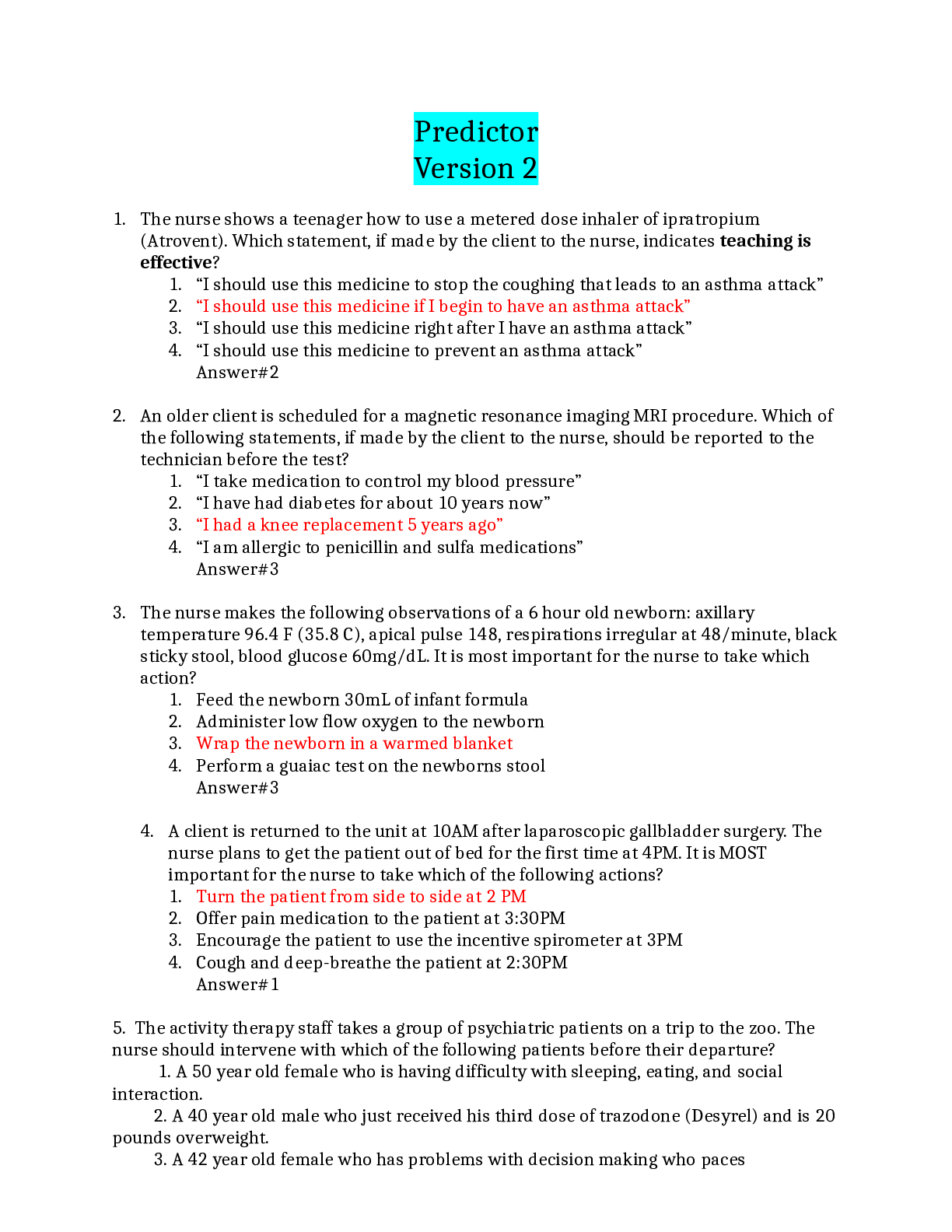
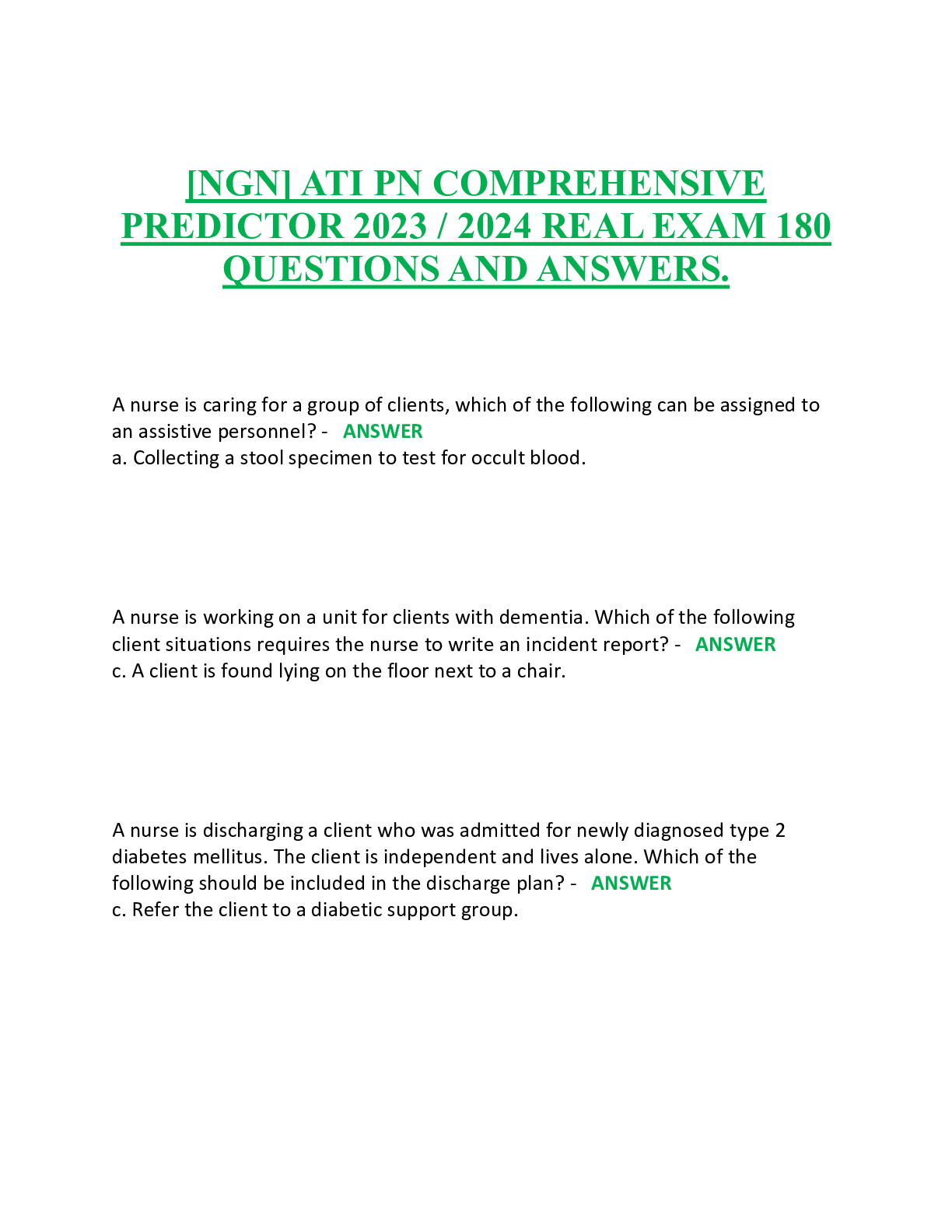
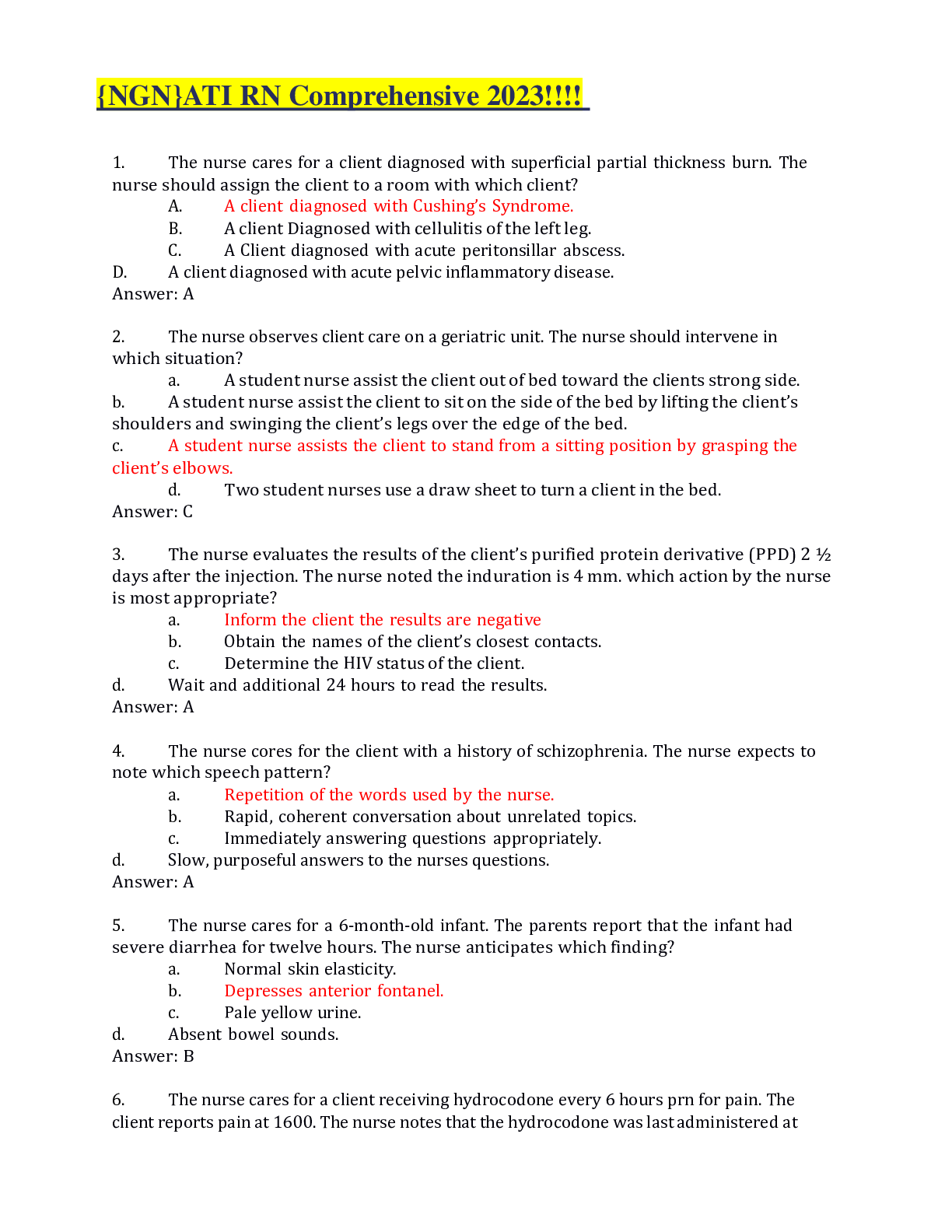
.png)
